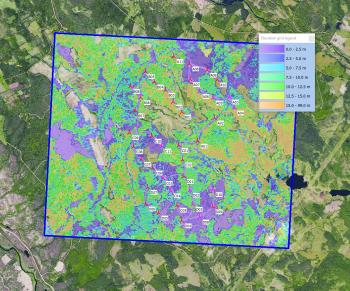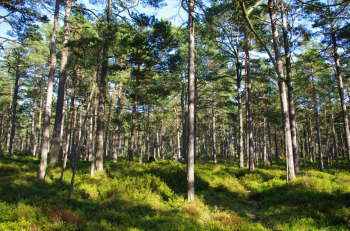Category:Forest Maps: Difference between revisions
No edit summary |
mNo edit summary |
||
| (5 intermediate revisions by the same user not shown) | |||
| Line 1: | Line 1: | ||
[[Category:Online Data]] | [[Category:Online Data]] | ||
[[ | [[Image:ForestHeights_Sweden.png|350px|right|thumb|SLU Forest Map (tree heights) for a wind farm in Sweden]][[Image:SwedishForest_LakeVaneren.png|350px|right|thumb|Swedish Forest - at Lake Väneren]]The forest maps are used in the forest models in WindPRO - and used for energy yield calculations in forested terrain. Model data is used in the displacement height calculator and the Objective Roughness Approach (ORA). Data is stored from the ‘elevation grid object’ with data-type set to ‘Heights above terrain (a.g.l) for elements’. | ||
For an introduction to the ORA method and its benefits, we recommend the paper by Rogier Ralph Floors et al - "From lidar scans to roughness maps for wind resource modelling in forested areas". It is available as an open access paper from the Wind Energy Science journal, here: | For an introduction to the ORA method and its benefits, we recommend the paper by Rogier Ralph Floors et al - "From lidar scans to roughness maps for wind resource modelling in forested areas". It is available as an open access paper from the Wind Energy Science journal, available freely here: [https://doi.org/10.5194/wes-3-353-2018 DOI] or [https://orbit.dtu.dk/files/149876264/wes_3_353_2018.pdf DTU-Orbit (pdf)]. | ||
== Considerations == | == Considerations == | ||
When using the forest maps and tree heights, you must manually consider the accuracy of the dataset used. | When using the forest maps and tree heights, you must manually consider the accuracy of the dataset used. | ||
You can do this by accessing and inspecting recent orthophotos or satellite images (which could be the windPRO [http://help.emd.dk/mediawiki/index.php?title=WindPRO_European_Satellite_Imagery European Satellite Imagery] or the [http://help.emd.dk/mediawiki/index.php?title=WindPRO_Global_Satellite_Imagery Global Satellite Imagery]). | You can do this by accessing and inspecting recent orthophotos or satellite images (which could be the windPRO [http://help.emd.dk/mediawiki/index.php?title=WindPRO_European_Satellite_Imagery European Satellite Imagery] or the [http://help.emd.dk/mediawiki/index.php?title=WindPRO_Global_Satellite_Imagery Global Satellite Imagery]). | ||
Latest revision as of 23:55, 18 March 2020


The forest maps are used in the forest models in WindPRO - and used for energy yield calculations in forested terrain. Model data is used in the displacement height calculator and the Objective Roughness Approach (ORA). Data is stored from the ‘elevation grid object’ with data-type set to ‘Heights above terrain (a.g.l) for elements’.
For an introduction to the ORA method and its benefits, we recommend the paper by Rogier Ralph Floors et al - "From lidar scans to roughness maps for wind resource modelling in forested areas". It is available as an open access paper from the Wind Energy Science journal, available freely here: DOI or DTU-Orbit (pdf).
Considerations
When using the forest maps and tree heights, you must manually consider the accuracy of the dataset used. You can do this by accessing and inspecting recent orthophotos or satellite images (which could be the windPRO European Satellite Imagery or the Global Satellite Imagery).
Pages in category "Forest Maps"
The following 10 pages are in this category, out of 10 total.